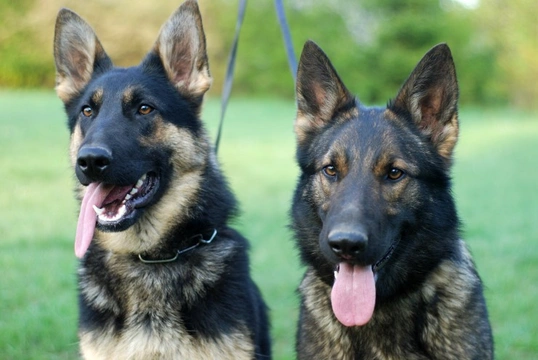
Walking two dogs on the lead together safely and sensibly
dog owners think that having two dogs can’t be that much more hassle than having one, but they usually soon change their minds about this!
It is important to train each of your dogs individually and give them plenty of one on one time, as well as working with both of your dogs together-but when it comes to walking, the chances are that if you don’t walk your dogs together and instead have to take them each out separately, you’ll soon find that you have little time for anything else!
This means that you will have to get both yourself and both of your dogs used to walking on their leads with you together, and ensure that you can manage them safely and sensibly when out and about.
If you’re not sure how to go about this or have already tried and been firmly put off by tangled leads, different walking paces and lots of pulling, don’t despair-in this article we will look at how to walk two dogs together on the lead safely and sensibly, and cover some of the problems that you might find yourself facing along the way. Read on to learn more.
The dogs as individuals
Before you can hope to take two dogs out together successfully, they will each need to be trained individually to be able to walk on the lead to heel and respond to your commands like sitting at junctions without any hassle. It is also wise to work through any pulling on the lead issues that you have with either dog before you start taking them out together, because two dogs pulling can be a real challenge to manage, and even one dog pulling whilst the other behaves can be almost as problematic in itself.
Matching the dogs
If both of your dogs are the same approximate height and have a similar walking pace, this can make co-walking easier-but even if you have a very small dog and a very large dog, walking them together should be possible.
However, you will have to bear in mind several different elements if your dogs are not a good match in terms of their size, stride or activity levels, and accept that one dog may need an extra walk or some time on their own to be able to move at their own pace without being brought up regularly so that the other dog can catch up.
Obviously, both dogs need to be able to get on well enough together that the walk is not going to lead to fighting or too much messing about, but this is something that you can work with over time once you have got to grips with the basics.
Choosing the right leads
When it comes to working out what collar and lead arrangement works best for your dog, the number of different options are almost limitless, and what works for you will come down to a combination of trial and error, and your personal preferences.
If you are walking two dogs that have uneven paces and stride lengths, the smaller dog (or the one with the shorter stride) will likely need a longer lead and more room to range when walking side by side, to allow for the difference in pace.
You also have several options in terms of keeping both dogs on separate leads or using a splitter lead, which gives you one handle and then separate leashes attached to each dog.
There are even various pieces of kit used for dog spots like sledding that can be useful in some cases as well, like a sturdy waist belt with the leads attached to this-although walking in this way is a whole skill in its own right, which again needs practice and work.
Choosing the right approach
Getting your two dogs used to walking on the lead together is something that takes practice, but choosing your approach and being able to provide clear direction to each dog when they are together-which means having a few dry runs working with both dogs together, and teaching them to respond to a direction given to them individually, without your command causing the other dog to change their behaviour too.
You should at a minimum work on the type of commands that you would need to use in an emergency or if the safety of yourself, the dogs or someone else depended on it-such as teaching the dogs a “stop” command, at which they both stand still where they are and await further direction.
It is wise to start your trial walks after your dogs have had some off-lead time and worked the worst of their energy out of their systems, as this will make them more open to learning and following directions. Once your dogs are able to work reliably together on their leads at the end of a walk, you can then start thinking about setting off from the get-go with both dogs, and providing their off-lead time later on.



